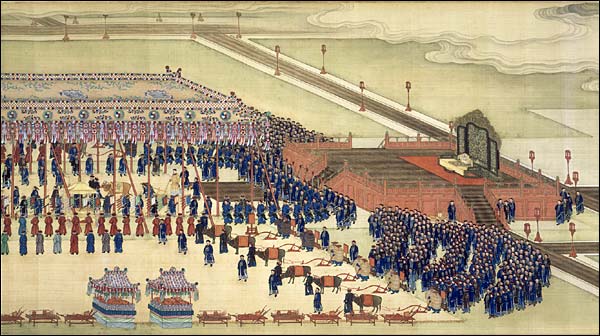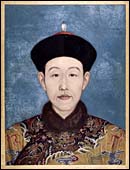To celebrate the fifth anniversary of its reopening after renovation, the Guimet Museum presents to the public for the first time an exceptional collection of painted scrolls, imperial commissions intended to celebrate events marking the reign of three great sovereigns Qing: Kangxi (1662-1723), Yongzheng (1723-1736) and Qianlong (1736-1796). More than 100 works from the Ming and Qing dynasties are presented: monochrome scrolls and album sheets, paintings on fans, engravings, porcelain, albums of imperial seals and works dealing with perspectives.
One of the great moments of the history of China
The reign of these three powerful emperors represents one of the great moments of the history of China. Thus, several events throughout the world have recently been dedicated to them: at the Musée de Versailles, the exhibition Kangxi, at the Royal Academy of Arts in London - organised together with the Museum of the Forbidden City in Peking - China: The Three Emperors 1662-1795. Both received high public acclaim. Now the Guimet Museum will bring a major contribution to this subject by showing, for the first time in Paris, a real treasure among its collections, the nine imperial scrolls, some of which measure up to sixteen metres. This is a unique opportunity to discover works, too precious to be presented to the public, apart from during exceptional events, and which also bear testimony to imperial politics as is clearly demonstrated by the imperial visits in the provinces, the ceremonies marking the solar calendar, the embassies and the hunts which represent for the Manchus and the Mongols genuine military exercises.
The wonder of the miniatures from the mediaeval Very Rich Hours
From these scrolls in sumptuous colours, in front of these scenes brimming with life which abound in picturesque details of the poetic landscapes forming a real panorama of seventeenth and eighteenth century China, the visitors experience the wonder one feels in front of the miniatures from the mediaeval Very Rich Hours. They may notice, equally, how much this painting, stemming from a deep Chinese tradition exercised a real power of attraction on the occidental artists invited to collaborate on several imperial commissions, in particular the Jesuit painter Castiglione, who became the official painter to Emperor Qianlong. His touch can be recognised in several of the Guimet Museum’s scrolls. The National Museum of the Palace of Taipei lent to this exhibition two works by this artist, including the famous painting The Empress Watching over the Sericulture Rites
The power of attraction of Chinese aesthetics
Testimonies of Castiglione’s collaboration with the Chinese artists serve as a point of reference in the comparison between two fascinating traditions through the very fact of the distance that lies between them: the Chinese tradition and the European tradition. The power of attraction of Chinese aesthetics on occidental artists is such that their approval of China will even lead them to take a Chinese name… From the Museum’s rich collections in the two fields of painting and porcelain, through the technical and stylistic processes of the painting, the public may ponder over the spatial arrangement of the landscape designs, characters and even the historiated scenes, as well as the role given to perspective in the occidental manner.
Illustration: Portrait of emporer Qianlong Giuseppe Castiglione (chinese name Lang Shining, 1688-1766) Qing dynasty, Qianlong period (1736-1795) circa 1737 H. 56,2 ; L. 42,3 Colours on paper Musée national des Arts asiatiques-Guimet MG 26586 (C) Photo RMN / © Thierry Ollivier
PUBLICATIONS:
Exhibition catalogue , 240 pages, 298 colour illustrations, co-publication RMN/ musée Guimet :45 €
Petit journal de l’exposition 3, 50 €
To see more illustrations, click on VERSION FRANCAISE at the top of this page
| 








